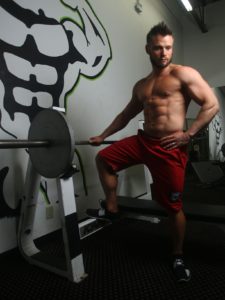This article is aimed at beginners who are looking to achieve their first muscle up and progress into some slightly more advanced versions with progressively stricter form. The extent of the progressions I’m explaining here will cover the basics up to strict false-grip weighted muscle ups. If you would like to see some even more advanced versions of the muscle up I would recommend watching this tutorial from BarStarzz:[/vc_column_text][vc_video link=”https://www.youtube.com/watch?time_continue=2&v=YxBf7Vgh4Lc” align=”center”][vc_column_text css=”.vc_custom_1509575792162{padding-bottom: 24px !important;}”]There are several variations of muscle ups, but all require some basic pre-requisites:
- At least 10 pull-ups in one set
- At least 15-20 dips in one set
- The ability to pull your chest up to the bar
As I mentioned earlier, there are several different variations of the muscle up, some are easier than others. One thing to note about the above requirements is that muscle ups become incredibly easier if you use a kip (it does not look quite as badass however). If you can get your chest above the bar with a kipping pull-up for at least 10 reps, you probably have enough strength to do kipping muscle ups, it is just a matter of practicing the correct form and body control.[/vc_column_text][/vc_column_inner][vc_column_inner column_padding=”no-extra-padding” column_padding_position=”all” background_color_opacity=”1″ width=”1/2″ column_border_width=”none” column_border_style=”solid”][image_with_animation image_url=”3390″ alignment=”center” animation=”Fade In” box_shadow=”none” max_width=”100%”][/vc_column_inner][/vc_row_inner][vc_column_text css=”.vc_custom_1509575871668{padding-bottom: 24px !important;}”]
Muscle Ups: One Arm At A Time
I started doing muscle ups a couple of years ago when I saw some crazy videos of guys like Frank Medrano and Hannibal for King doing muscle ups, front levers, one-arm pull-ups and all sorts of other crazy bodyweight movements. Initially the only way I could actually get myself over the bar was one arm at a time. If you are having a tough time transitioning from pull-up to dip on the bar, you can start by doing one arm over the bar at a time. It requires some flexibility but the more you do the more comfortable you will become with pulling yourself above the bar. I started off adding ~30 muscle ups (regardless of how long it took) to the beginning of my workouts 3-4 days a week.
At first I could only do one or two of these “one arm at a time” muscle ups before dropping to the ground. As I continued doing these nearly every morning, I started to get more comfortable and my shoulder and elbow joints became stronger. If you have the strength, it is likely that not being able to pull yourself over the bar (both arms at the same time) is a mental barrier that you need to break through. Performing muscle ups one arm over at a time will help you feel comfortable with the movement and eventually you will surprise yourself and both arms will pull you over at the same time (this happened for me after ~2 weeks of doing muscle ups one arm at a time). See the video below for an example of muscle ups done one arm at a time.[/vc_column_text][vc_video link=”https://youtu.be/78uCaB936qs” align=”center”][vc_column_text css=”.vc_custom_1509575899827{padding-bottom: 24px !important;}”]
Muscle Ups: Using Momentum
Now, once you have become comfortable pulling yourself over the bar one arm at a time, you may be ready for the next step. The next step (for me) in muscle up progression was using my momentum to get up and over the bar. If you know how to kip up to the bar, it is likely you know how much easier it is to get up to the bar than using strict form. The only reason I am recommending that you use a kip to learn muscle ups is that it will help you become more comfortable with the motion of transitioning from hanging below the bar to pressing yourself over the bar.
A kip is not a pull-up as you are hardly using your upper body to pull yourself up to the bar. Instead of using your arms and back to pull yourself up, the kip utilizes momentum created by the swinging or kicking of your legs to essentially “throw” yourself upwards. This is just another technique that will help you perform the transition from pulling to pushing. The video below shows examples of using momentum from the legs as well as momentum created by the whole body to pull myself up and over the bar.[/vc_column_text][vc_video link=”https://youtu.be/TcOnjCSchYY” align=”center”][vc_column_text css=”.vc_custom_1509575922047{padding-bottom: 24px !important;}”]
Kipping with False Grip
Once you have become comfortable utilizing your momentum to pull yourself up and over the bar, you may be itching to advance your muscle ups to the next level. The next progression that I advanced to after being able to perform ~10-15 muscle ups with a kip was the false grip muscle up. With the false grip it is much easier to achieve a muscle up without using momentum.[/vc_column_text][vc_row_inner equal_height=”yes” content_placement=”middle” column_margin=”default” text_align=”left”][vc_column_inner column_padding=”no-extra-padding” column_padding_position=”all” background_color_opacity=”1″ width=”1/2″ column_border_width=”none” column_border_style=”solid”][vc_column_text]”What is a false grip?” you may ask; the false grip is basically a grip which puts your wrists on/above the bar versus below it. With your wrists already above the bar, you make it much easier to transition from pulling to pushing. The false grip is, however, hard on your wrists.
If you are not comfortable with the false grip I would recommend hanging from the bar or rings in the false grip position or doing pull-ups with a false grip. This type of grip puts a lot of stress on the wrist joint and it may help to put some chalk on the lower half of your hand.[/vc_column_text][/vc_column_inner][vc_column_inner column_padding=”no-extra-padding” column_padding_position=”all” background_color_opacity=”1″ width=”1/2″ column_border_width=”none” column_border_style=”solid”][image_with_animation image_url=”3391″ alignment=”center” animation=”Fade In” box_shadow=”none” max_width=”100%”][/vc_column_inner][/vc_row_inner][vc_column_text css=”.vc_custom_1509576046106{padding-bottom: 24px !important;}”]All of the same rules apply when performing a false grip muscle up, the only difference is that you may find it much easier to transition into a dipping position because your hands are already in somewhat of a pushing/dipping position versus hanging in a normal grip. Below are a few videos of the false grip muscle up.[/vc_column_text][vc_video link=”https://youtu.be/NjGOkOT0FEQ” align=”center”][vc_column_text css=”.vc_custom_1509576071260{padding-bottom: 24px !important;}”]
Weighted Muscle Ups
When you are comfortable with the false grip muscle up, try adding some weight to further strengthen your muscle up:[/vc_column_text][vc_video link=”https://youtu.be/y7cRykv3gjY” align=”center”][vc_column_text]As I mentioned earlier, these are just some of the progressions that worked for me (I’m still learning). Everyone is different and some of you may be able to skip all of these progressions and go straight to strict form muscle ups without a false grip (see BarStarzz video above). In short, a muscle up is a combination of three different movements: pulling up to the bar, transitioning wrists over the bar into a dipping position, performing a straight bar dip.
If you are still having trouble with muscle ups, it may be helpful to try some of these progressions on a bar that has a gap in the middle where your chest ends up. This makes it easier to move your center of mass in line with the bar and transition to the dipping position. You can also try using rings although this can sometimes be more difficult because the rings are not stable. If you are having trouble finishing the muscle up, you can try doing straight bar dips by using a box or barbell to position yourself above the bar to begin with.[/vc_column_text][/vc_column][/vc_row]






